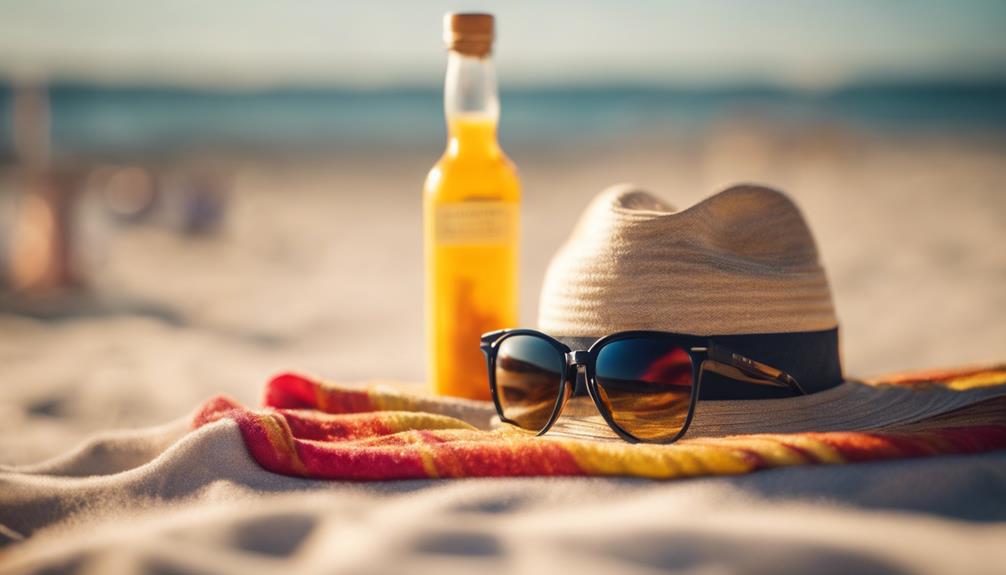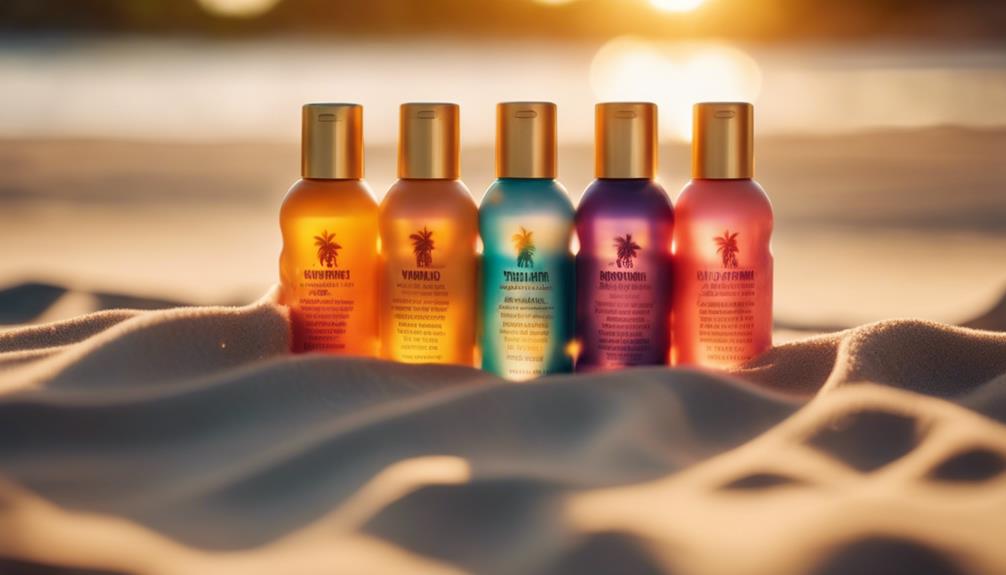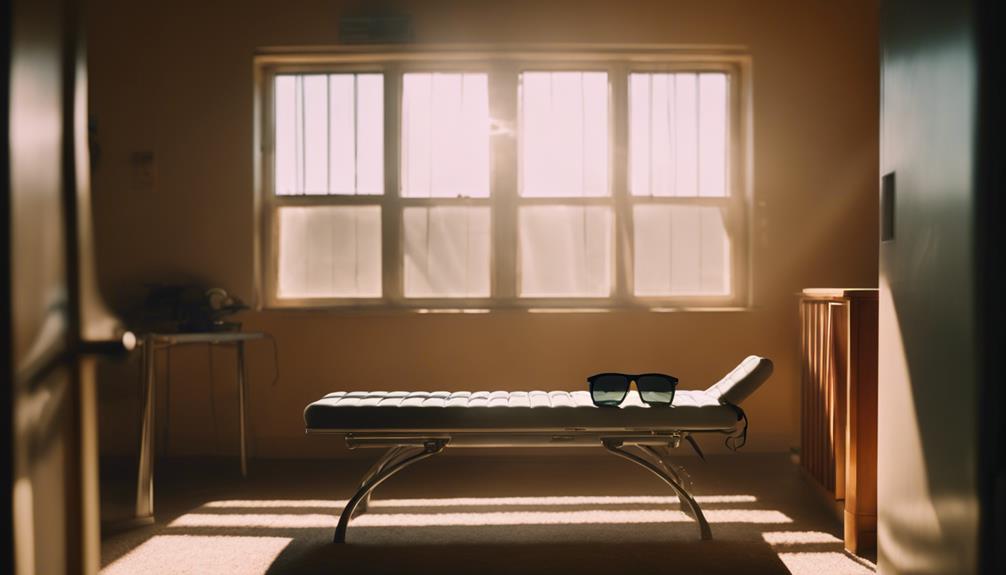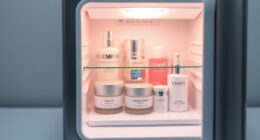To achieve a safe, sun-kissed glow, you've gotta start with sunscreen—SPF 30 or higher is your best friend! Make sure it's broad-spectrum to block those pesky UVA and UVB rays. Don't forget to slather it on generously and reapply every two hours, especially after splashing in the pool. If you're planning to lounge on the beach, look for water-resistant options that can hold up for about 80 minutes. Toss in some hydrating tanning oils for that smooth finish, and you'll be rocking that glow without turning into a lobster. Stick around, and you'll find even more sun-savvy tips!
Key Takeaways
- Apply a broad-spectrum sunscreen with SPF 30 or higher to protect your skin from harmful UV rays.
- Use water-resistant formulas if you'll be swimming or sweating to maintain sun protection.
- Reapply sunscreen every two hours, and immediately after swimming or towel drying for optimal safety.
- Consider using tanning oils after sunscreen application to enhance your tan while keeping your skin hydrated.
Importance of Sunscreen
Wearing sunscreen is essential for protecting your skin from harmful UV rays while achieving that sun-kissed glow you desire. You don't want to turn into a lobster, right?
Choosing a sunscreen with SPF 30 or higher is your best bet for keeping your skin safe and looking fabulous. It's like giving your skin a shield against those sneaky UV rays!
Make sure to pick a broad-spectrum formula to protect against both UVA and UVB rays. Remember, reapplying every two hours is key, especially after swimming or sweating.
And hey, if you're fair-skinned or plan to bask in the sun for a while, go for a higher SPF. Your skin will thank you, and you'll be rocking that glow without the burn!
Water-Resistant Formulas

Choosing a water-resistant sunscreen is essential if you plan to spend time in the water or sweat, as it helps maintain effective sun protection even during those activities.
You wouldn't want to end up looking like a lobster, right? Look for formulas labeled 'water-resistant,' which are typically effective for up to 80 minutes. This means you can splash around or sweat it out without worrying as much about UV rays.
Just remember, even the best water-resistant sunscreen needs a little love—reapply after swimming or towel drying to keep that protection going strong. Think of it as a sunscreen's way of saying, “I've got your back!”
Proper Application Techniques

Applying sunscreen properly is essential for maximizing its effectiveness and ensuring your skin stays protected from harmful UV rays. Think of it as your skin's superhero cape!
Here are some tips to make sure you're applying it like a pro:
- Apply generously and evenly to all exposed areas, including your ears and the tops of your feet.
- Use a spray or lotion, but don't be shy—more is better!
- Make sure to apply it about 15 minutes before you head out into the sun, so it can do its magic.
With these tips, you'll be ready to enjoy the sun while keeping your skin safe and happy!
Selecting the Right Sunscreen

Finding the right sunscreen is key to ensuring your skin gets the protection it needs while achieving that desired tan. You want a sunscreen that not only safeguards your skin but also complements your tanning goals. Here's a handy table to help you choose:
| Feature | What to Look For |
|---|---|
| SPF Level | Choose SPF 30+ for better protection |
| Broad Spectrum Protection | Blocks both UVA and UVB rays |
| Skin Type Compatibility | Match ingredients to your skin type |
| Water Resistance | Essential for pool or beach days |
When selecting, consider your skin type, planned activities, and personal preferences. Remember, a little research can go a long way, so don't just grab the first bottle you see—your skin will thank you!
Features of Popular Products

Popular sunscreens each offer unique features that cater to different skin types, preferences, and tanning goals. You'll find options that not only protect your skin but also enhance your tanning experience. Here are some standout features to reflect on:
- Hydration Boost: Ingredients like aloe vera and coconut oil keep your skin moisturized and happy.
- Water Resistance: Perfect for beach days, these sunscreens stay put even when you plunge into the waves.
- Natural Ingredients: Many brands use vegan and reef-friendly components, so you can feel good about your choice.
With these cool features, you'll be all set to enjoy that safe, sun-kissed glow while keeping your skin protected!
Advantages and Disadvantages

Understanding the advantages and disadvantages of different sunscreens can help you make an informed choice for achieving a safe, sun-kissed glow.
On the bright side, using a broad-spectrum sunscreen protects your skin from harmful UVA and UVB rays, reducing the risk of sunburn and premature aging—who doesn't want that?
Plus, many sunscreens offer added hydration and antioxidants, making your skin feel fabulous!
However, there are some downsides. Some sunscreens can feel greasy or heavy, while others may require frequent reapplication, which can be a hassle at the beach.
Also, low SPF options mightn't provide enough protection, especially for fair skin.
Benefits of Tanning Oils

Tanning oils enhance your sun-kissed glow by promoting a deeper tan while keeping your skin hydrated and nourished.
They're like magic potions for your skin, giving you that gorgeous bronze without sacrificing moisture. Plus, they often smell fantastic, making your tanning session feel like a mini-vacation!
Here are some benefits of using tanning oils:
- Deeper Color: Helps you achieve that rich, golden tan faster.
- Hydration: Enriched with natural oils, they keep your skin moisturized.
- Barrier Protection: Forms a protective layer against sun damage.
Tips for Effective Use

To maximize the benefits of tanning oils while ensuring your skin stays protected, it's important to follow a few effective application tips.
First off, don't skimp on the sunscreen! Apply a broad-spectrum SPF 30 or higher, especially if you're planning to soak up those rays for a while.
Remember to cover all those tricky spots, like your ears and the back of your knees, because they love to get sunburned.
Reapply every two hours, or more often if you're swimming or sweating.
Oh, and don't forget to wait about 15 minutes after applying before you plunge into the sun!
With these simple steps, you'll be well on your way to a fabulous, sun-kissed glow without the nasty burns.
Happy tanning!
Frequently Asked Questions
Can I Use Expired Sunscreen for Tanning?
You shouldn't use expired sunscreen for tanning. Its effectiveness diminishes over time, leaving your skin vulnerable to UV damage. Always check expiration dates and choose a fresh product to guarantee proper protection while tanning.
How Do I Properly Store Sunscreen Products?
Treat your sunscreen like fine wine; store it in a cool, dark place to preserve its potency. Keep it tightly sealed and avoid extreme temperatures to guarantee it remains effective when you need it most.
What Ingredients Should I Avoid in Sunscreens?
When choosing sunscreen, avoid ingredients like oxybenzone, parabens, and synthetic fragrances. These can irritate your skin or disrupt hormones. Instead, look for mineral-based options with zinc oxide or titanium dioxide for safer protection.
How Does Diet Affect Skin Tanning?
Your diet considerably affects skin tanning. Consuming foods rich in antioxidants, vitamins A, C, and E can enhance your skin's ability to tan and protect against sun damage, promoting a healthier, more vibrant appearance.
Can I Tan Safely During Cloudy Days?
Cloudy days might seem safe, but UV rays still penetrate the clouds. You can tan, but don't forget to apply sunscreen. It's essential for protecting your skin, even when the sun isn't shining directly.
Can Non-Bronzer Lotions Achieve a Safe Sun-Kissed Glow?
Looking for a natural, bronzer-free way to achieve a sun-kissed glow? Natural glow lotions without bronzer can provide a safe alternative by enhancing your skin’s natural radiance without the risk of exposure to harmful UV rays. Achieve a healthy, luminous complexion without the need for artificial bronzers.
Conclusion
So, if you want that gorgeous, sun-kissed glow without the risk of sunburn, remember to rock your sunscreen every time you step outside.
Did you know that about 90% of skin aging is caused by sun exposure? Yikes!
By choosing the right products and applying them properly, you can enjoy the sun safely.
So go ahead, soak up those rays, but do it wisely.
Your skin will thank you, and you'll look fabulous doing it!









